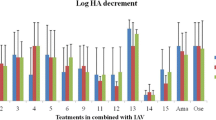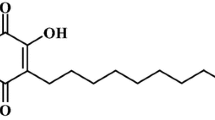Abstract
Lemon balm derivatives are going to acquire a novelty as natural and potent remedy for treatment of viral infections since the influenza viruses are developing resistance to the current antivirals widely. Oseltamivir, Melissa officinalis essential oil (MOEO) and their synergistic efficacy against avian influenza virus (AIV) subtype H9N2 were evaluated in vitro in MDCK cells at different time exposure by using TCID50, HA, Real Time PCR and HI assay. The results showed that MOEO could inhibit replication of AVI through the different virus replication phase (P ≤ 0.05). Also the highest antiviral activity of MOEO was seen when AIV incubated with MOEO before cell infection. The TCID50/ml was reduced 1.3–2.1, 2.3–2.8, 3.7–4.5 log 10 than control group (5.6 log 10), HAU/50 µl was decreased 85–94, 71.4–94, 71.4–94 % and viral genome copy number/µl was brought down 68–95, 90–100, 89.6–99.9 % at pre-infection, post-infection and simultaneous stage, respectively. Hemagglutination inhibition result showed the MOEO was not able to inhibit agglutination of the chicken red blood cell (cRBC). Replication of the AVI was suppressed by the different concentration of oseltamivir completely or near 100 %. Also oseltamivir showed a synergistic activity with MOEO especially when oseltamivir concentration reduced under 0.005 mg/ml. The chemical composition was examined by GC–MS analysis and Its main constituents were identified as monoterpenaldehydes citral a, citral b. In conclusion, the findings of the study showed that lemon balm essential oil could inhibit influenza virus replication through different replication cycle steps especially throughout the direct interaction with the virus particles.



Similar content being viewed by others
References
Abbaszadegan A, Sahebi S, Gholami A, Delroba A, Kiani A, Iraji A. Time-dependent antibacterial effects of Aloe vera and Zataria multiflora plant essential oils compared to calcium hydroxide in teeth infected with Enterococcus faecalis. J Investig Clin Dent. 2016;7(1):93–101.
Alexander DJ. A review of avian influenza in different bird species. Vet Microbiol. 2007;4:3–13.
Astani A, Reichling J, Schnitzler P. Screening for antiviral activities of isolated compounds from essential oils. Evid Based Complement Alternat Med. 2011;. doi:10.1093/ecam/nep187.
Astani A, Reichling J, Schnitzler P. Comparative study on the antiviral activity of selected monoterpenes derived from essential oils. Phytother Res. 2010;24:673–9.
Astani A, Reichling J, Schnitzler P. Melissa officinalis extract inhibits attachment of herpes simplex virus in vitro. Chemotherapy. 2012;58(1):70–7. doi:10.1159/000335590.
Choi HJ, Song JH, Park KS, Kwon DH. Inhibitory effects of quercetin 3-rhamnoside on influenza A virus replication. Eur J Pharm Sci. 2009;37:329–33.
Clabicz J, Galasinski W. The components of Melissa officinalis L. that influence protein biosynthesis in avitro. J Pharmacol Pharmacother. 1986;38:791–4.
Davies WL, Grunert RR, Haff RF, Mcgahen JW, Neumayer EM, Paulshock M, Watts JC, Wood TR, Hermann EC, Hoffmann CE. Antiviral activity of 1-adamantanamine (amantadine). Science. 1964;144:862–3.
Ehrhardt C, Hrincius ER, Korte V, Mazur I, Droebner K, Poetter A, Dreschers S, Schmolke M, Planz O, Ludwig S. A polyphenol rich plant extract, CYSTUS052, exerts anti influenza virus activity in cell culture without toxic side effects or the tendency to induce viral resistance. Antiviral Res. 2007;76:38–47.
Fleming DM. Managing influenza: amantadine, rimantadine and beyond. Int J Clin Pract. 2001;55:189.
Garozzo A, Timpanaro R, Stivala A, Bisignano G, Castro A. Activity of Melaleuca alternifolia (tea tree) oil on influenza virus A/PR/8: study of the mechanism of action. Antiviral Res. 2011;89:83–8.
Gilling DH, Kitajima M, Torrey JR, Bright KR. Mechanisms of antiviral action of plant antimicrobials against murine norovirus. Appl Environ Microbiol. 2014;80(16):4898–910.
Gómez LA, Stashenko E, Ocazionez RE. Comparative study on in vitro activities of citral, limonene and essential oils from Lippia citriodora and L. alba on yellow fever virus. Nat Prod Commun. 2013;8:249–52.
Haidari M, Ali M, Ward Casscells Iii S, Madjid M. Pomegranate (Punica granatum) purified polyphenol extract inhibits influenza virus and has a synergistic effect with oseltamivir. Phytomedicine. 2009;16:1127–36.
Han Y. Synergic effect of grape seed extract with amphotericin B against disseminated candidiasis due to Candida albicans. Phytomedicine. 2007;14(11):733–8.
Hemaiswarya S, Kruthiventi AK, Doble M. Synergism between natural products and antibiotics against infectious diseases. Phytomedicine. 2008;15(8):639–52.
Imanishi N, Tuji Y, Katada Y, Maruhashi M, Konosu S, Mantani N, Terasawa K, Ochiai H. Additional inhibitory effect of tea extract on the growth of influenza A and B viruses in MDCK cells. Microbiol Immunol. 2002;46:491–4.
Jong MD, Tran TT, Truong HK, Vo MH, Smith GJ, Nguyen VC, Bach VC, Phan TQ, Do QH, Guan Y, Peiris JS, Tran TH, Farrar J. Oseltamivir resistance during treatment of influenza A (H5N1) infection. N Engl J Med. 2005;353:2667–72.
Mantani N, Andoh T, Kawamata H, Terasawa K, Ochiai H. Inhibitory effect of Ephedrae herba, an oriental traditional medicine, on the growth of influenza A/PR/8 virus in MDCK cells. Antiviral Res. 1999;44:193–200.
Mazzanti G, Battinellia L, Pompeoa C, Serrillib AM, Rossic R, Sauzulloc I, Mengonic F, Vulloc V. Inhibitory activity of Melissa officinalis L. extract on Herpes simplex virus type 2 replication. Nat Prod Res. 2008;22:1433–40.
Mosleh N, Dadras H, Mohammadi A. Molecular quantitation of H9N2 avian influenza virus in various organs of broiler chickens using TaqMan real time PCR. J Mol Genet Med. 2009;16:152–7.
Nili H, Asasi K. Avian influenza (H9N2) outbreak in Iran. Avian Dis. 2003;47:828–31.
Nili H, Mohammadi A, Habibi H, Firouzi S. Pathogenesis of H9N2 virus in Chukar partridges. Avian Pathol. 2013;4:230–4.
Palese P. Influenza: old and new threats. Nat Med. 2004;10:S82–7.
Pleschka S, Stein M, Schoop R, Hudson JB. Anti-viral properties and mode of action of standardized Echinacea purpurea extract against highly pathogenic avian Influenza virus (H5N1, H7N7) and swine-origin H1N1 (S-OIV). Virol J. 2009;6:197.
Pourghanbari GH, Nili H, Moattari A, Mohammadi A. Effect of Oseltamivir on avian influenza A virus (H9N2) replication in cell culture. OJVR. 2013;17:450–9.
Reed LJ, Muench H. A simple method of estimating fifty per cent endpoints. Am J Epidemiol. 1938;27:493–7.
Schnitzler P, Schuhmachera A, Astania A, Reichling JUR. Melissa officinalis oil affects infectivity of enveloped herpesviruses. Phytomedicine. 2008;15:734–40.
Shabby AS, El-Gengaihi S, Khattab M. Oil of Melissa officinalis L., as affected by storage and herb drying. J Essent Oil Res. 1995;7:667–9.
Song JH, Choi HJ. Silymarin efficacy against influenza A virus replication. Phytomedicine. 2011;18(10):832–5.
Song JM, Lee KH, Seong BL. Antiviral effect of catechins in green tea on influenza virus. Antiviral Res. 2005;68:66–74.
Wolkerstorfer A, Kurz H, Bachhofner N, Szolar OHJ. Glycyrrhizin inhibits influenza A virus uptake into the cell. Antiviral Res. 2009;83:171–8.
Yamada K, Ogawa H, Hara A, Yoshida Y, Yonezawa Y, Karibe K, Nghia VB, Yoshimura H, Yamamoto Y, Yamada M, Nakamura K, Imai K. Mechanism of the antiviral effect of hydroxytyrosol on influenza virus appears to involve morphological change of the virus. Antiviral Res. 2009;83:35–44.
Acknowledgments
This work was supported by a grant from School Of Veterinary Medicine at Shiraz University.
Author information
Authors and Affiliations
Corresponding author
Electronic supplementary material
Below is the link to the electronic supplementary material.
Rights and permissions
About this article
Cite this article
Pourghanbari, G., Nili, H., Moattari, A. et al. Antiviral activity of the oseltamivir and Melissa officinalis L. essential oil against avian influenza A virus (H9N2). VirusDis. 27, 170–178 (2016). https://doi.org/10.1007/s13337-016-0321-0
Received:
Accepted:
Published:
Issue Date:
DOI: https://doi.org/10.1007/s13337-016-0321-0




